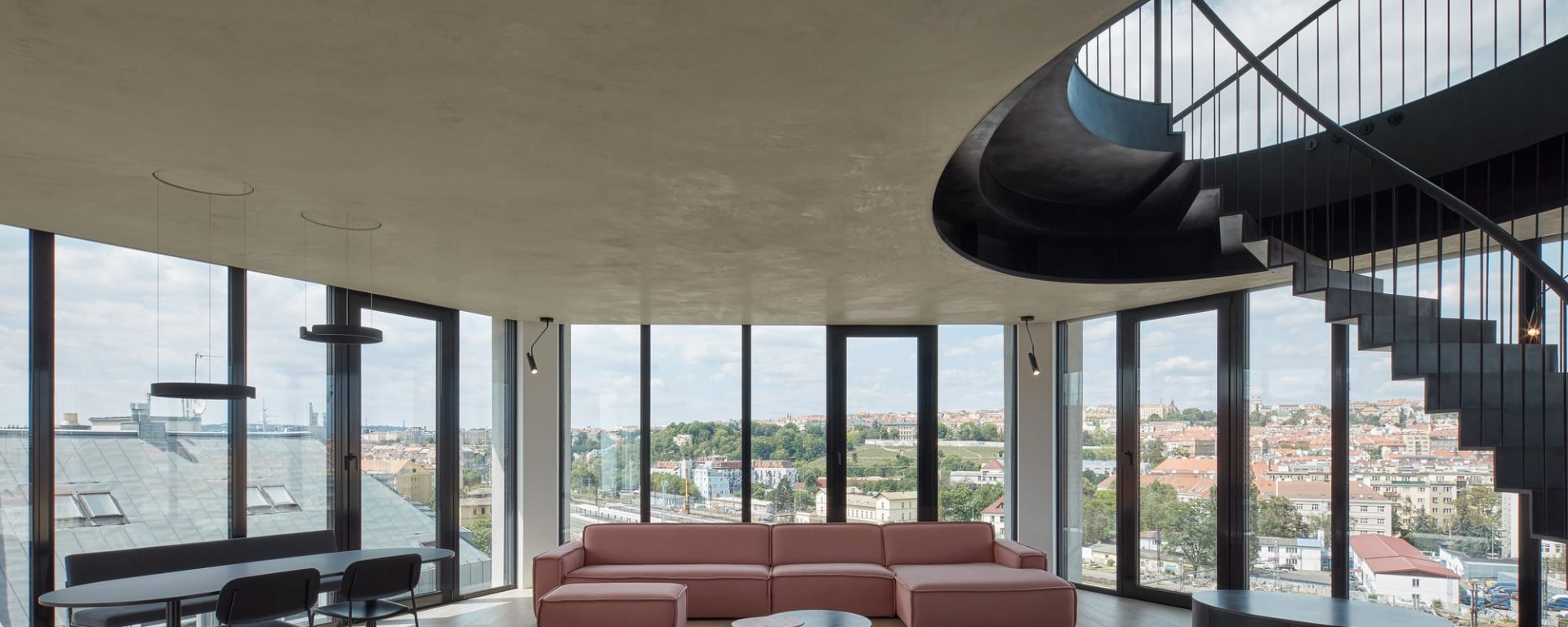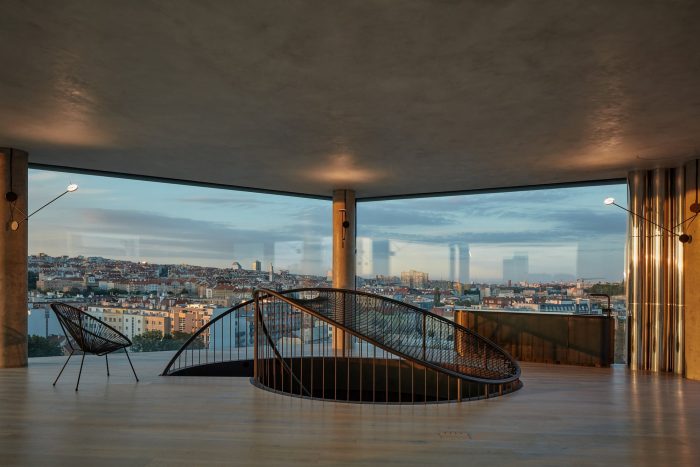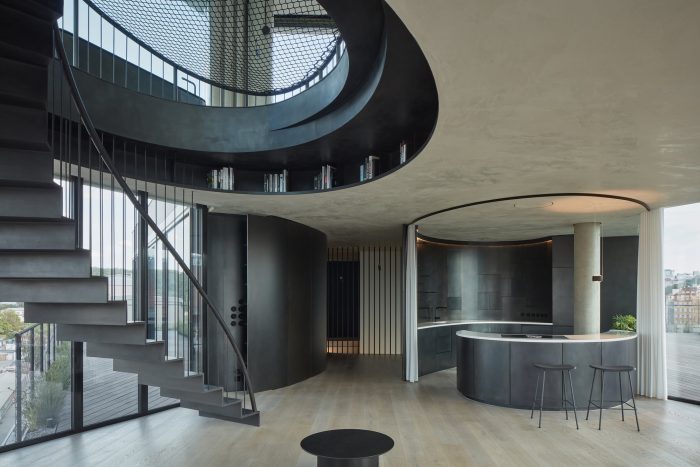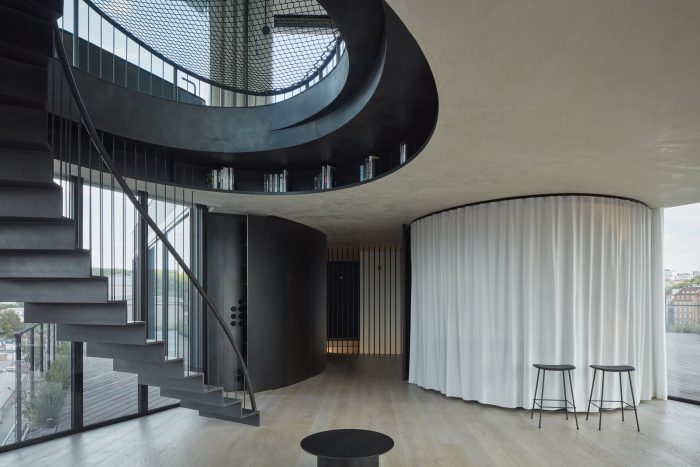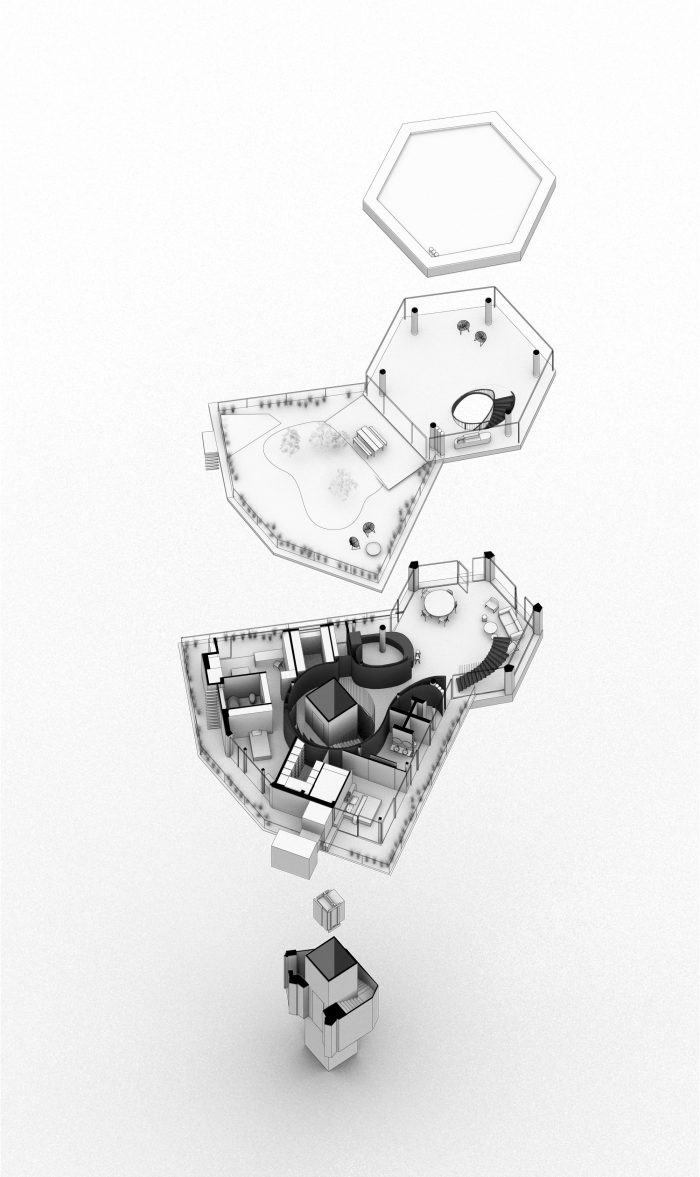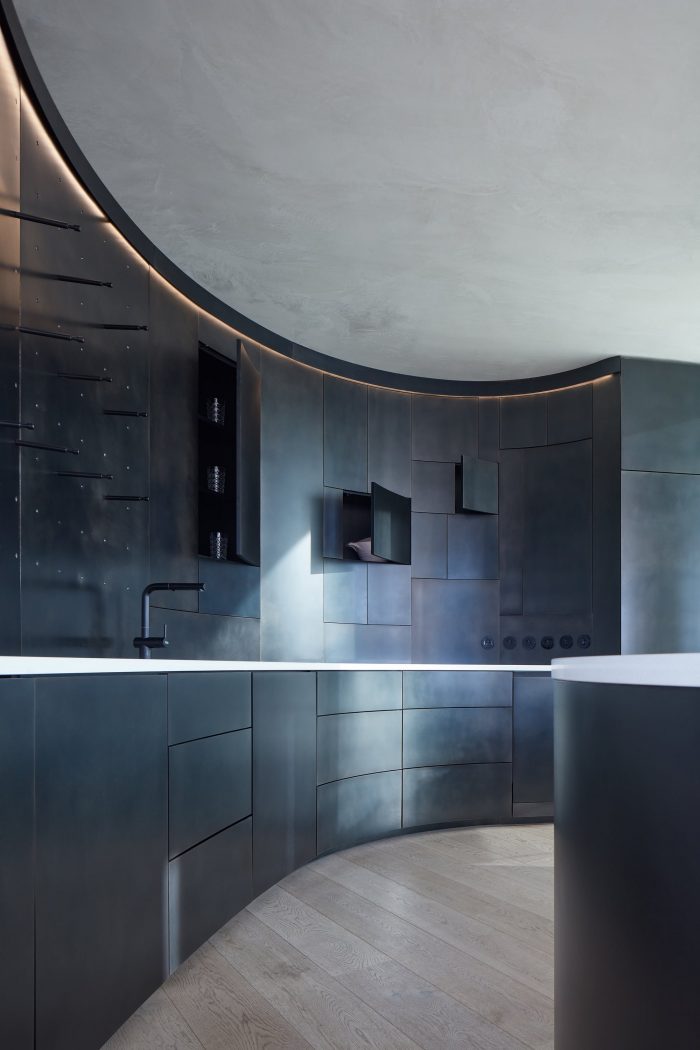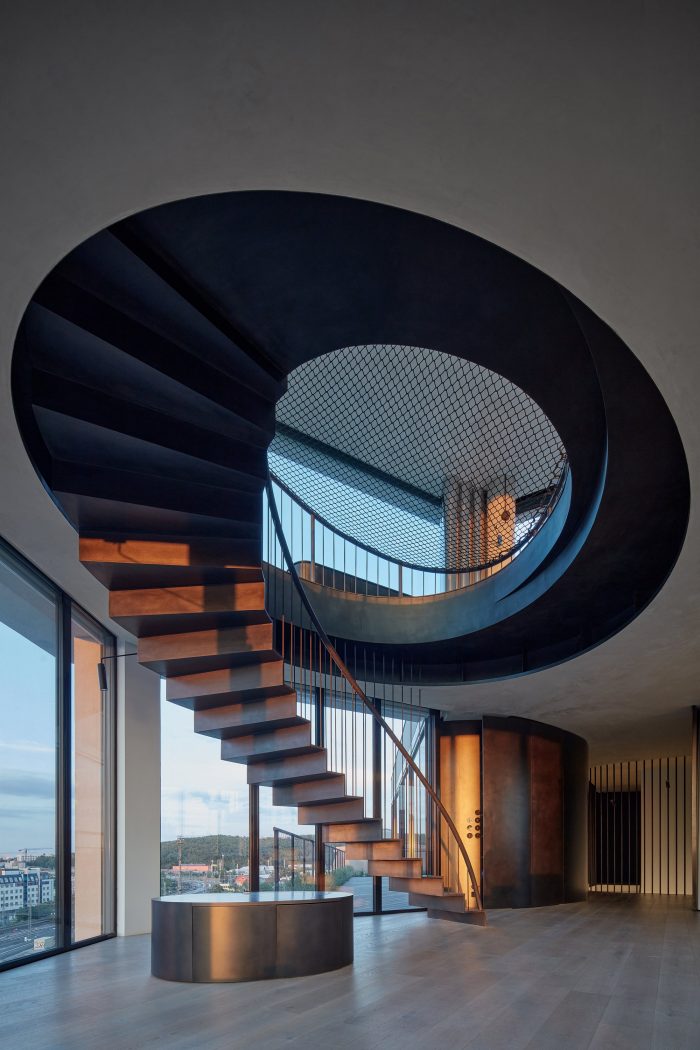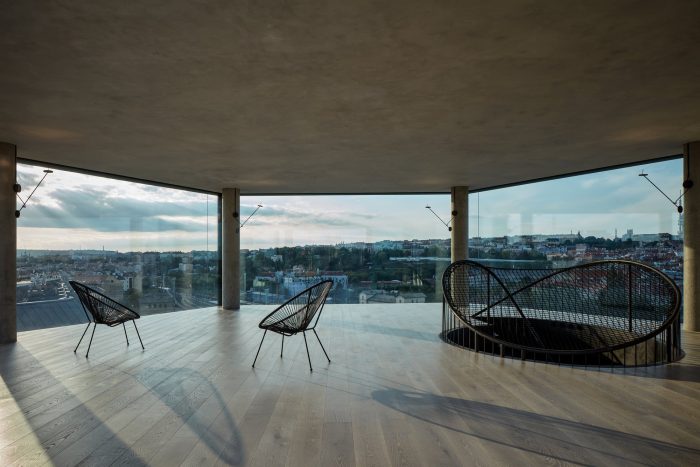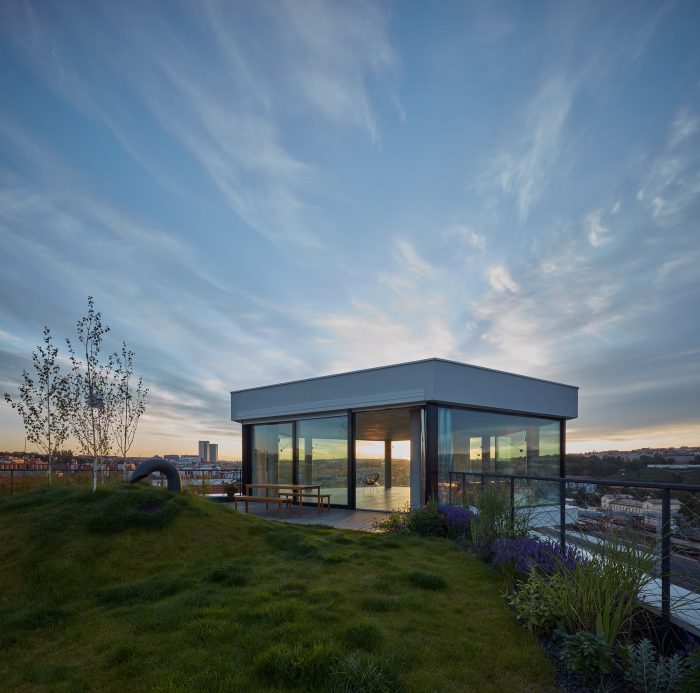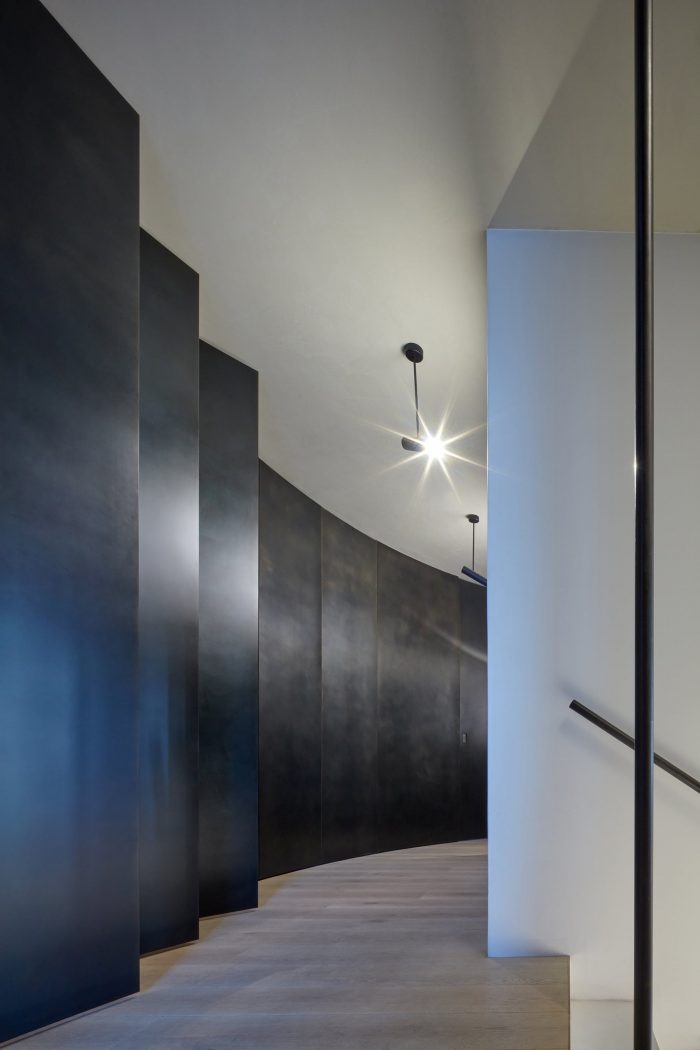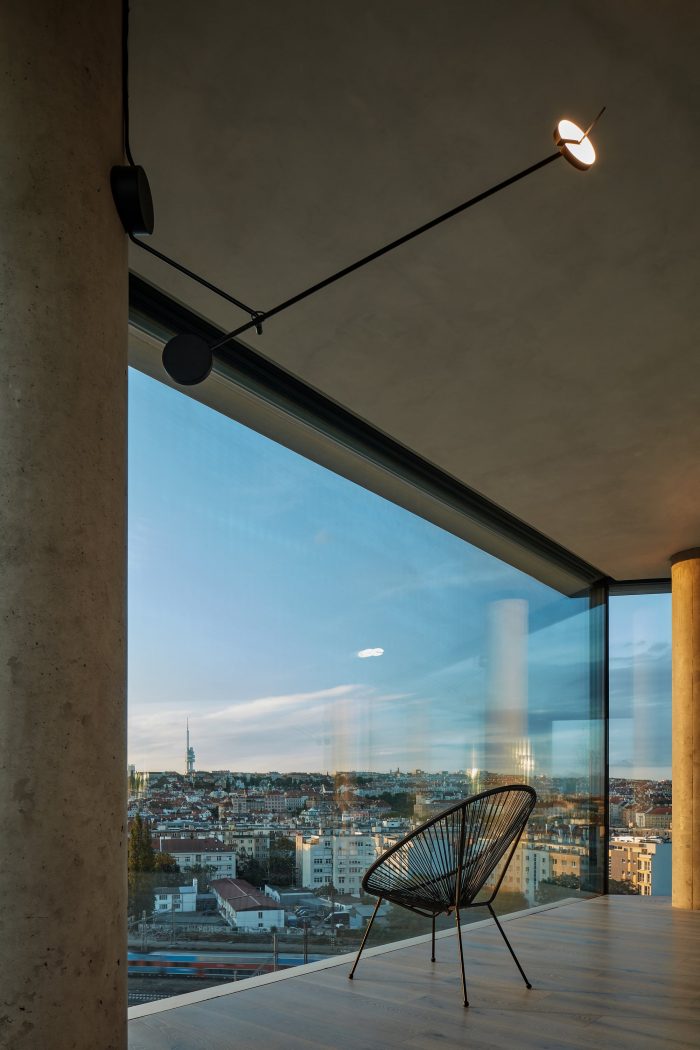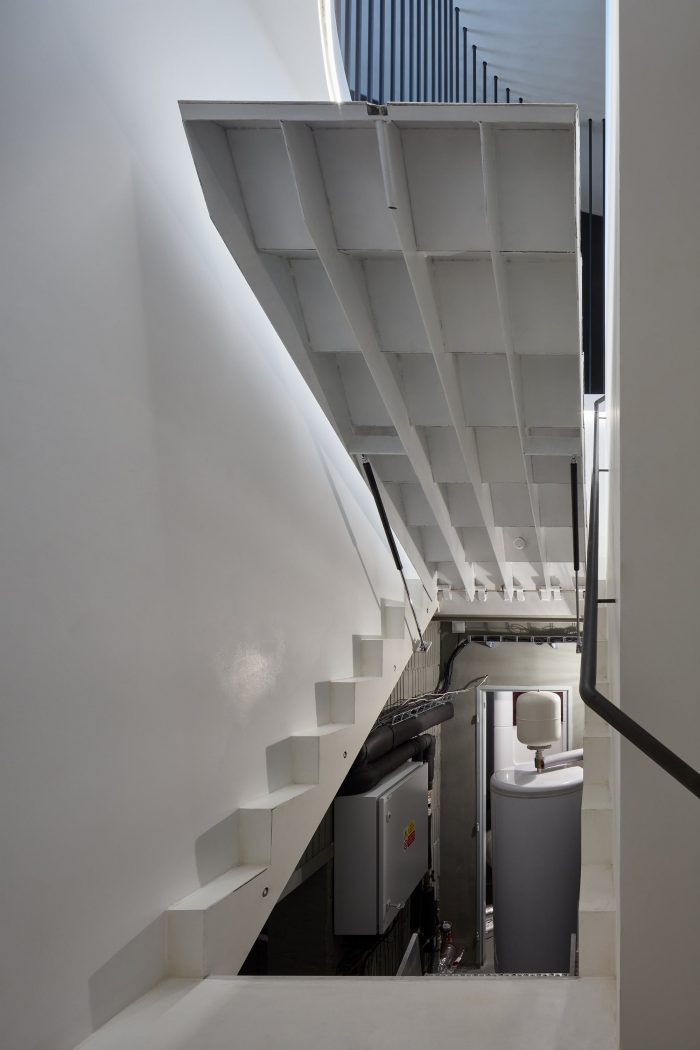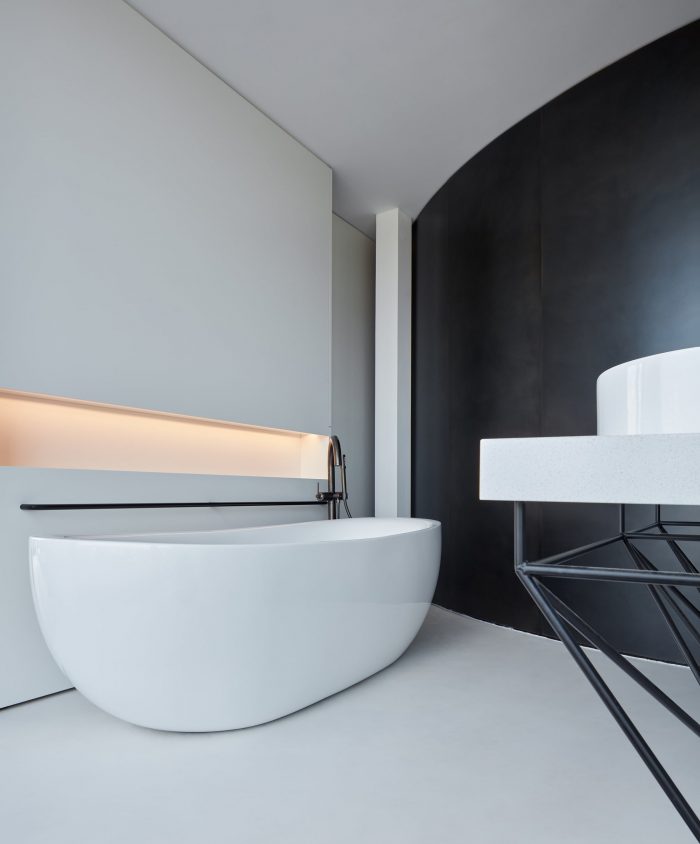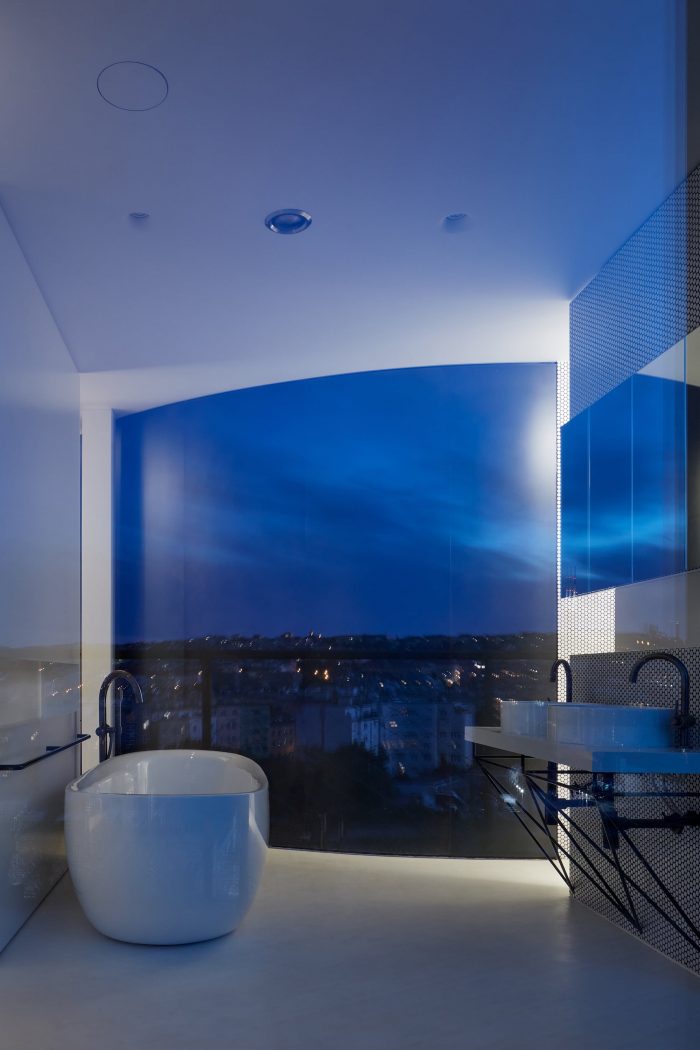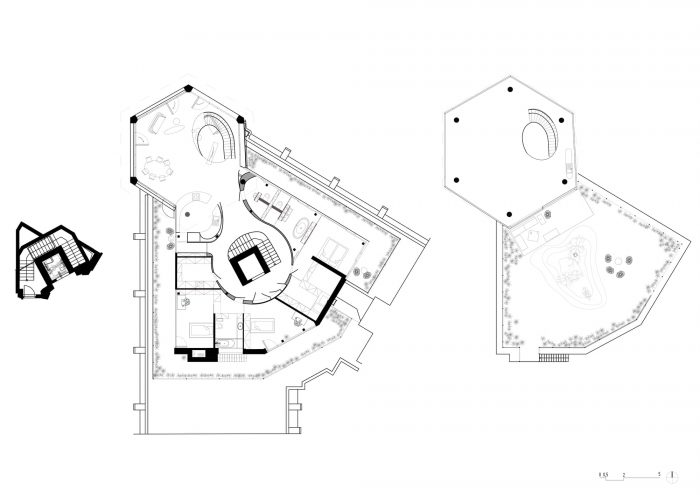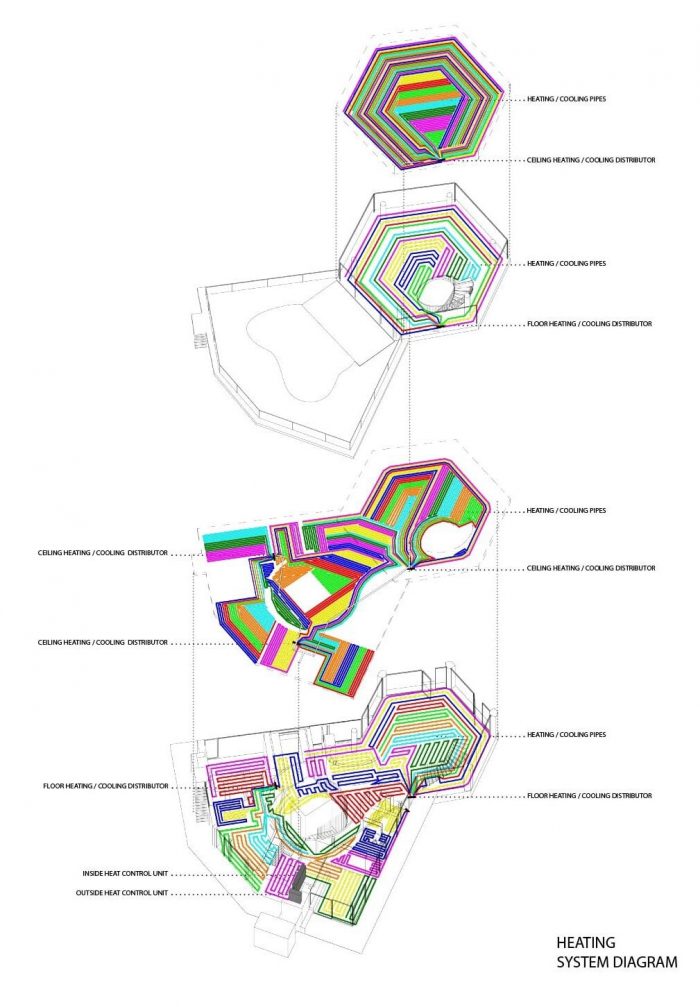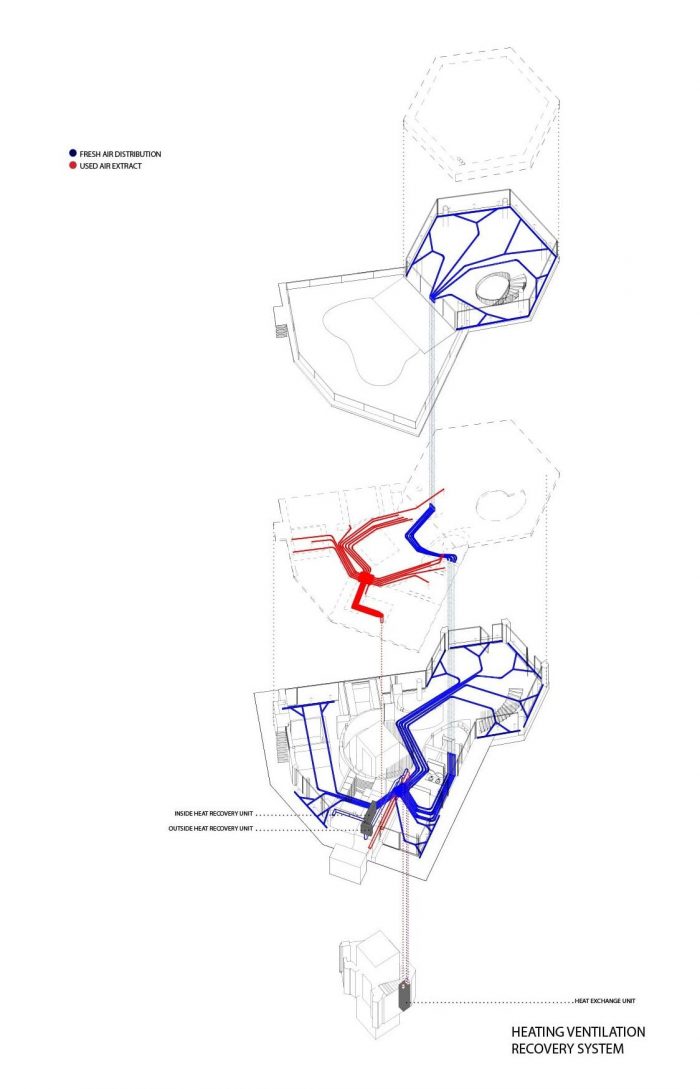主要的想法是模糊公寓的边界,并在情感上将城市吸引到其内部。公寓的空间不局限于物理布局,建筑周围的城市成为它的一部分,增加的外墙玻璃只保持了室内气候的舒适性,将城市连接到一个扩展的外围感知。原来的公寓被重建成了一个顶楼:房子上的房子。
The main idea is to blur the boundaries of the apartment and emotionally draw the city into its interior. The space of the apartment is not limited to the physical layout, the city surrounding the building becomes part of it and the added facade glazing only maintains the comfort of the indoor climate, connecting the city into an extended peripheral perception. The original apartment was rebuilt into a penthouse: a house on a house.
场地规划的概念是基于 “场地 “的特征和潜力;在这个案例中,在一个角落的房子里有两个屋顶楼层,位于建筑区的边界,穿过山谷进入远处视野的广阔背景。
The site plan concept is based on the character and potential of the “site”; in this case, two roof-top floors in a corner house on the border of a built-up area that opens across the valley into the extensive context of distant views.
建筑设计借鉴了顶楼高于周围所有建筑的独特叠加方式,并利用了全景的优势。它修正了开发商对建筑原属地所做的妥协性重建的影响,明确了外部元素之间的所有细节关系,特别是在塔楼上层的大面积玻璃,允许从所有的窗户看到壮观的景色,而对各个玻璃区域的划分却最小。
The architectural design draws on the unique superposition of the penthouse above all surrounding buildings and takes advantage of the panoramic view. It revises the impact of the compromising reconstruction done by a developer towards the original genius loci of the building, clarifying all the detailed relationships between the exterior elements, especially in the large-area glazing in the upper floor of the tower, allowing a spectacular view from all windows with the minimal division of individual glazed areas.
由于我们设计的这部分建筑不可能与历史内涵相结合(它是一个上层建筑,部分重建了原水库的角楼,并增加了翼楼),而且它是为类型学上不同的用途(住房)而重新改造的,所以我们没有与该建筑有争议的 “工业 “特征或具有明显阁楼特征的审美主义相结合。主题是室内空间的自由和连续流动,以及它对周围城市的无尽的光学延续。
As it is not possible to work with the historical connotation in the part of the building we designed (it is a superstructure, partially re-created corner tower of the original water reservoir with added wings) and it is a reconversion for typologically different use (housing), we do not work with the debatable “industrial” character of the building or with aestheticism with clear loft features. The leitmotif is the free and continuous flow of the interior throughout the space and its endless optical continuation into the surrounding city.
在结构上,它是通过主要的重建手段对粗糙的结构进行客户重建,包括对在壳和芯的状态下移交的层进行重大干预。作为干预措施的一部分,开发商所做的周边覆层被完全拆除,取而代之的是非典型的大面积玻璃,使用结构性的四层玻璃,并通过大屏幕百叶窗进行相应的遮挡,优化热量的获得和损失,与室内气候控制系统一起确保最大的用户舒适性。所有的隔断都被拆除,以创造一个连续的布局。由于是在建筑过程中接手的,设计尊重了现有的承重结构(除了一根柱子被替换了),并将其整合到布局中,通过合并和引导它们在地板和天花板上使用剩余的空间(入口楼梯下面)作为技术基础,简化了安装核心。
Structurally, it is a client reconstruction of the rough structure by means of major reconstruction, including significant interventions in the layers handed over in the shell-and-core state. As part of the intervention, the perimeter cladding done by the developer was completely removed and replaced with atypical large-format glazing using structural four-pane glazing with the corresponding shading by large-screen blinds, optimizing heat gains and losses and ensuring maximum user comfort, together with the indoor climate control system. All partitions were removed to create a continuous layout. As it was taken over during the building process, the design respects the existing load-bearing structures (with the exception of one column, which was replaced) and integrates them into the layout, simplifying the installation cores by merging and leading them in the floor and ceiling using the residual spaces (below the entrance staircase) as a technical base.
所用的材料与轻盈和大部分白色的空间相对应,并通过一个主要的深色钢制隔断将其分为两个 “世界”。它的表面从两面进行处理,使用蚀刻、打磨和抛光,在热轧黑钢板上夹着木纤维板。所有的门和开口都是无框的,被切割成这个隔断的连续表面。地板由垂直于主立面的宽木板制成,贯穿整个公寓,并延续到露台上的木板。
The materials used correspond to the light and mostly white space and its division into two “worlds” by a dominant dark steel partition. Its surface is treated from both sides using etching, sanding, and polishing on a hot-rolled black steel sheet sandwiched on a wood-fiber board. All of the doors and openings are frameless, cut into the continuous surface of this partition. The floor is made of wide planks running perpendicular to the main facade through the entire apartment and continuing to the planks on the terraces.
天花板采用了精细的纹理,包括灯光和空调的凹陷部分,以及用于悬挂秋千和上层其他元素的集成罩。室内楼梯的栏杆创造了一个上升和下降的曲线,以便尽可能少地打断全景,并配备了一个吊床,可以进入扶手接触到地板的地方。空间的照明采用漫反射光和隐藏的线条,衬托出隔断的曲线。
The ceilings are finished with a fine texture, including the recessed parts of the lights and air conditioning and integrated covers for hanging swings and other elements on the upper floor. The railing of the interior staircase creates a rising and descending curve so as to interrupt the panoramic view as little as possible and is equipped with a hammock with access to the place where the handrail touches the floor. The space is lit using diffused reflected light and hidden lines lining the curves of the partitions.
该项目采用了高端技术解决方案,相当于目前可实现的最先进的标准。这些技术被有意地隐藏起来,因此,实际上是看不见的,并且仍然是公寓背景中的一种隐藏力量。室内温度控制是基于低温传输;温度变化是无法察觉的。该系统创造了一个环境气候,并保持了一个舒适的温度,在其交换过程中没有明显的空气流动。
The project works with a high-end technological solution corresponding to the most progressive standard currently achievable. The technologies are intentionally concealed, and therefore, practically invisible, and remain a hidden force in the apartment’s background. The indoor temperature control is based on low-temperature transmission; the temperature changes are not perceivable. The system creates an ambient climate and maintains a comfortable temperature without the obvious flow of air during its exchange.
隐蔽的供暖和制冷分布与地板和天花板融为一体,通过衬托窗户的缝隙分布的空调也几乎看不见,不会影响公寓的视觉设计。主要的能源是隐藏在露台上一个声学分离的竖井中的空气-空气热泵。最大限度开放的外墙辅以白色的大型外墙屏风,遮挡阳光,即使关闭时也保持内部透明,以保持与城市的联系。
The hidden heating and cooling distribution are integrated into the floors and ceilings, and the air-conditioning distributed through the slits lining the windows is also almost invisible and does not distract from the visual design of the apartment. The primary energy source is an air-to-air heat pump hidden in an acoustically separated shaft on the terrace. The maximally open façade is complemented with large exterior screens in white that shade sunlight and remain transparent from the inside, even when closed, to maintain contact with the city.
Architects: petrjanda/brainwork
Area : 358 m²
Year : 2020
Photographs :BoysPlayNice
Manufacturers : BORA, Berker, Grohe, Koło, M&T, Nowodvorski, Occhio, Siemens, ATEH, Active Elements, DIAMOND DESIGN, Domus Aurea, EFF, EMPIRI Wood Design, GIGA LINE, Kurel, OBSIDIAN, One Light, Polysan, SALKOMA
Lead Architect : Petr Janda
Design Team : Anna Podroužková, Maty Donátová
City : Prague
Country : Czech Republic

